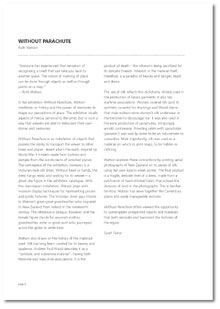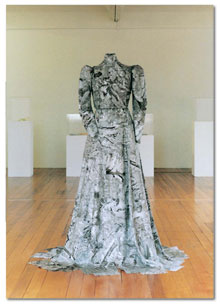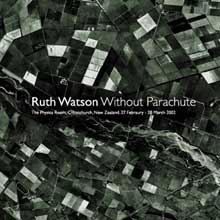 |
|||||||||
|
|
| ...Publications: Annual | ...The Physics Room Annual 2002 | ||||||||||||||
|
WITHOUT PARACHUTE “Everyone has experienced that sensation of recognising a smell that can take you back to another space. The notion of marking of place can be done through objects as well as through points on a map.” - Ruth Watson In her exhibition Without Parachute, Watson meditates on history and the power of memories to shape our perceptions of place. The exhibition recalls aspects of history personal to the artist, but in such a way that viewers are able to rediscover their own stories and memories. Without Parachute is an installation of objects that possess the ability to transport the viewer to other times and places. Jewels adorn the walls, inspired by World War II trinkets made from buttons and perspex from the windscreens of wrecked planes. The centrepiece of the exhibition, however, is a Victorian-style silk dress. Without head or hands, the dress hangs ready and waiting for its wearer - a ghost-like figure in the exhibition catalogue. With this mannequin installation, Watson plays with museum display techniques for representing private and public histories. The Victorian dress pays tribute to Watson’s great-great grandmother who migrated to New Zealand from Ireland in the nineteenth century. The reference is oblique, however, and the female figure stands for anyone’s mother, grandmother, sister or great aunt who journeyed across the globe to settle here. Watson also draws on the history of the materials used. Silk has long been coveted for its beauty and opulence. Andrew Paul Wood describes it as a “symbolic and subversive material”, having both feminine and masculine associations. It is the product of death - the silkworm being sacrificed for its delicate threads. Inherent in the material itself, therefore, is a paradox of beauty and danger, death and desire. The use of silk reflects this dichotomy. Widely used in the production of luxury garments, it also has wartime associations. Women coveted silk (and its synthetic variants) for stockings and Wood claims that male soldiers wore women’s silk underwear in the trenches to discourage lice. It was also used in the early production of parachutes, intriguingly, amidst controversy. Providing pilots with parachutes (parasols?) was said by some to be an inducement to cowardice. Most importantly, silk was used as a material on which to print maps, to be hidden in clothing. Watson explores these connections by printing aerial photographs of New Zealand on to pieces of silk using her own Epson inkjet printer. The final product is a fragile, delicate shell of a dress, made from a patchwork of hand-stitched fabric that echoes the divisions of land in the photographs. This is familiar territory. Watson has sewn together the Canterbury plains into easily manageable sections. Without Parachute offers viewers the opportunity to contemplate unexpected objects and materials that both resonate and transcend the histories of the region. Sarah Farrar This essay originally appeared in The Physics Room Annual 2002 Order your copy today from The Physics Room ! Related Without Parachute
|
||||||||||||||



